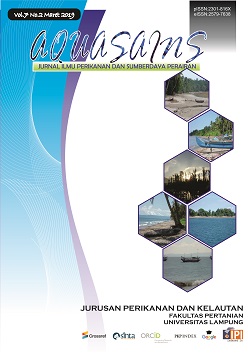EFFECT OF Pilsbryoconcha exilis AS ORGANIC MATTER REMOVAL IN THE RECIRCULATING AQUAPONIC SYSTEM
DOI:
https://doi.org/10.23960/aqs.v7i2.p725-734 Abstract View: 631
Abstract View: 631
Abstract
Aquaponics is a combination of aquaculture and hydroponics system. This system is expected to be able to overcome the problems of waste from aquaculture by utilizing Nitrogen (N) and Phosphorus (P) for vegetables. There are several obstacles found in aquaponics systems such as high suspended organic matter produced from the feed residue and fish metabolism. The addition of natural filters, namely freshwater mussels (Pilsbryoconcha exilis) is expected to solve these problems. This research was conducted for 40 days. The design used in this study was Factorial Completely Randomized Design with two main factors namely mussels density as factor-A and time of observation as factor-B. The treatments were P1 (0 mussels density), P2 (15 mussels density), and P3 (30 mussels density) for factor-A while time of observation were factor-B (D-0, D-10, D-20, D-30 and D-40). Each treatment was conducted in three repetition. The results showed that the time observation gave significantly different on water condition changes (P <0.05), which will increase TSS, turbidity and chlorophyll value along with the increasing of time. P exilis in aquaponics was effective in reducing turbidity and chlorophyll concentration (P <0.05). Therefore, aquaponics system with the highest mussels density (P3) with has lower turbidity and chlorophyll value than the one with 0 mussels density (P1).

.png)










